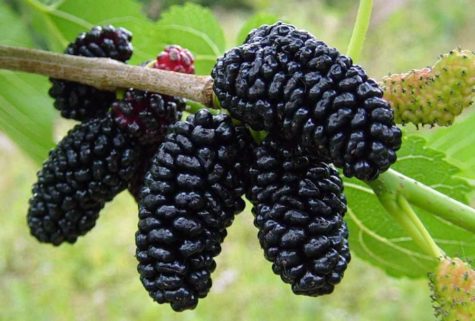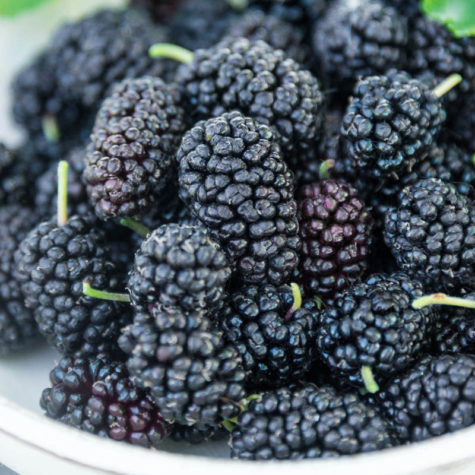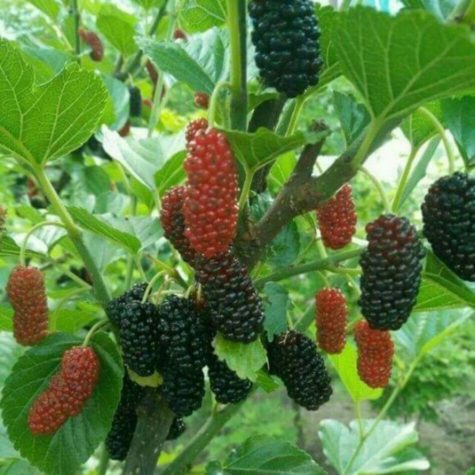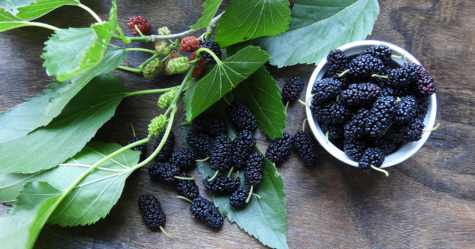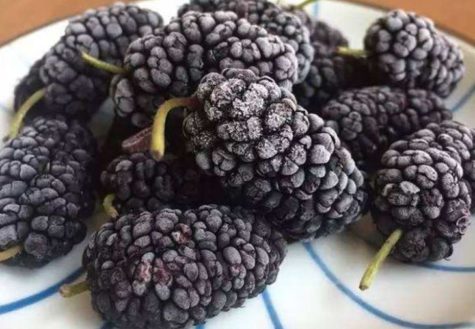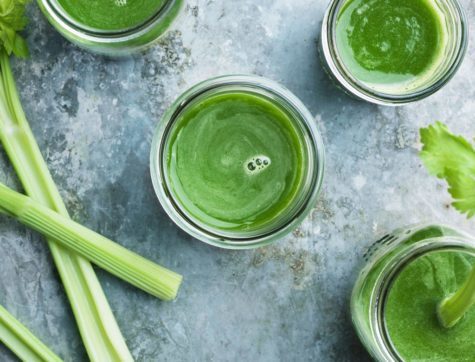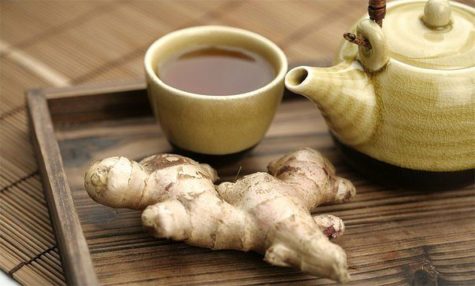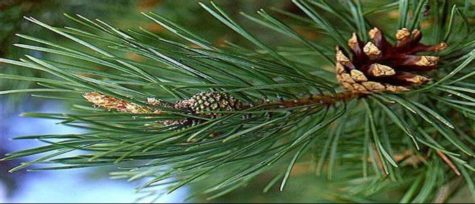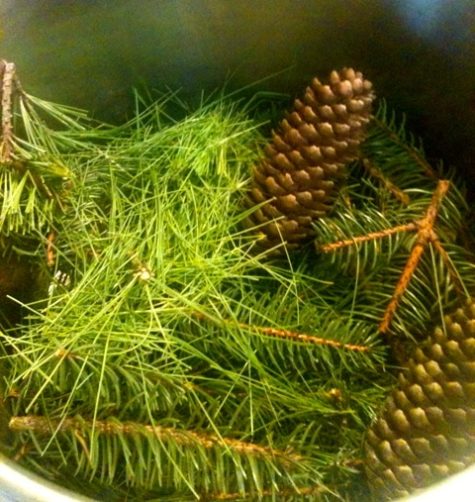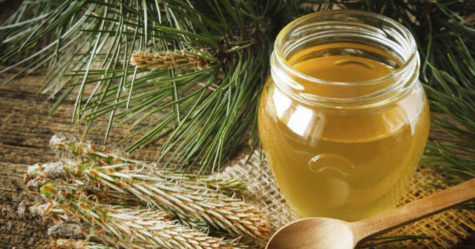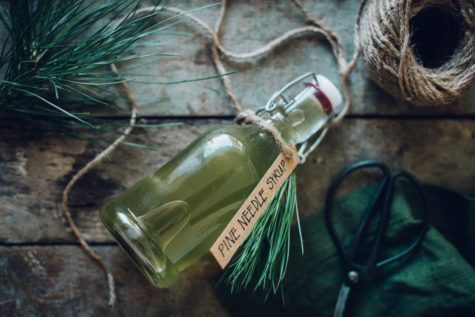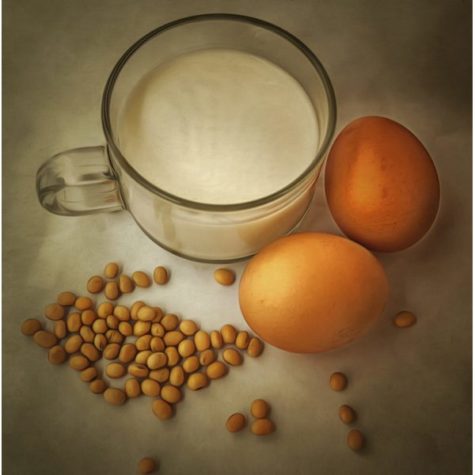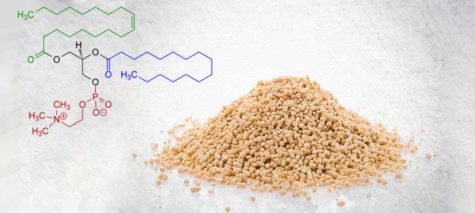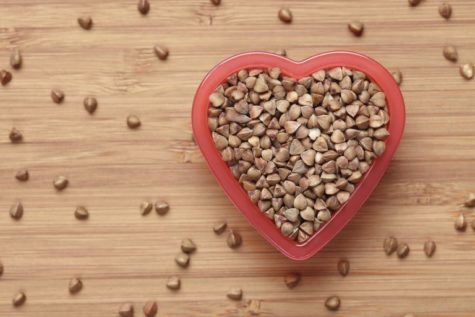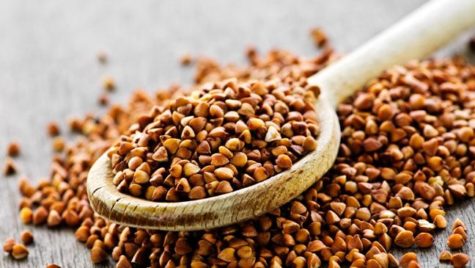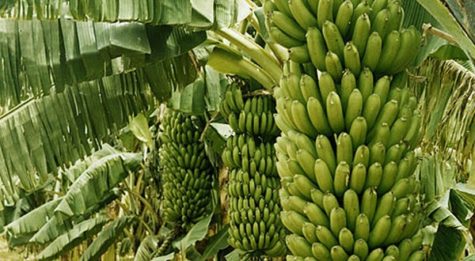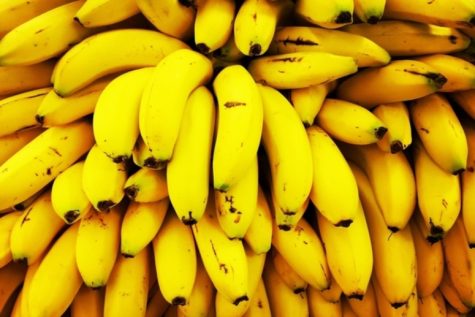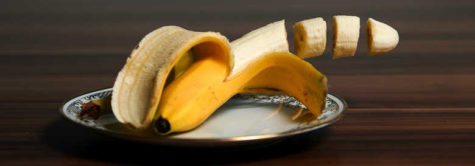Individual Foods
Mulberries Are Good For You
Mulberries are very high in antioxidants. They also contain large amounts of vitamin C as well as Vitamin K, Vitamin A, Vitamin E, really high levels of Iron, and Dietary Fiber and are high in minerals like potassium, manganese, and magnesium and contain the B vitamins, B6, Niacin, Riboflavin, and Folic Acid. Mulberries contain flavinoids and phyto-nutrients and are extremely high in anthocyanins.
A 3 1/2-ounce serving of raw Mulberries has 43 calories, can provide up to 44 percent of your daily value of vitamin C, and 14 percent of your iron needs. The fruit and leaves are sold in various forms as nutritional supplements. The mature plant contains significant amounts of resveratrol, particularly in the stem bark, which some speculate can lead to longevity.
- Improve Digestive Health
Mulberries are a boon for your stomach. They relieve constipation and are also an excellent way to lose weight. Mulberries contain a good amount of dietary fiber. Your body needs dietary fiber to facilitate proper digestion. It does so by bulking up a stool in the stomach and facilitating the movement of food through the digestive tract. This process helps in relieving constipation, bloating, and stomach cramps.
Healthy digestion helps in efficiently maintaining optimum weight. A research was conducted by Italy’s F. De Ritis Institute and the Catholic University of Sacred Heart to determine the weight loss capacity of Mulberries. It was found out that those who consumed Mulberries as part of a balanced diet plan of 1300 calories decreased to about 10% of their total body weight in nearly three months.
The researchers also noticed that the group which consumed Mulberries reduced drastically in the waist and thigh regions. So, all you people who want a slender waist and toned thighs, you know what to eat.
- Lower Cholesterol
Eating Mulberries is a good way to lower the levels of bad cholesterol in your body, which in turn helps in preventing cardiovascular problems.
- Control Blood Sugar Levels
White Mulberries, in particular, help in keeping a check on the sugar levels of the body. Certain chemicals present in white Mulberries are similar to the medicine used to treat type 2 diabetes.
These compounds in white Mulberry help in keeping the sugar levels of the body at an optimum range by slowly breaking down the sugars in the gut and allowing them to be absorbed slowly into the blood.
- Reduce Cancer Risk
If you are looking to protect yourself from cancer, then Mulberry is what you should be looking for. Mulberries are rich in antioxidants and phytonutrients that help in stopping the growth and spread of tumor cells and protect you from cancer.
Mulberries are full of anthocyanins that help in keeping cancer cells at bay. They also contain resveratrol, which has anti-cancer properties. Resveratrol cancer inhibiting properties help in fighting colon cancer, skin cancer, prostate cancer, and thyroid.
- Improve Blood Circulation
Mulberries improve blood flow through the body, control blood pressure, and cleanse the blood. The antioxidants present in Mulberries help in improving the function of the blood vessels by keeping them supple and dilated, which leads to blood pressure control as there is a free flow of blood from the heart to other parts of the body. Mulberries encourage the production of red blood cells as they are rich in iron.
Mulberries contain polyphenols that keep the blood vessels healthy. They also contain potassium, which lowers the blood pressure.
Mulberries have been used as a remedy for blood health since ages. Ancient Chinese medicine incorporated them in their blood tonics that were used to cleanse the blood and increase its production.
- Cure Anemia
Mulberries are great for curing anemia as they are rich in iron. They also cure the symptoms of anemia such as fatigue and dizziness.
- Better Heart Health
The fiber, antioxidants, and flavonoid content of Mulberries facilitate heart health. They help in maintaining a consistent flow of blood, thus preventing heart attacks and strokes. Mulberries are rich in polyphenols, which are considered healthy for the heart.
- Good For Vision
Like carrots, Mulberries too are good for your eyes. They improve your vision and protect your eyes from free radicals that are a cause of retinal degeneration and loss in eye sight. Mulberries contain zeaxanthin, which helps in reducing oxidative stress in the cells that form your eyes. The carotenoids present in Mulberries assist in preventing cataracts and macular degeneration.
- Promote Brain Health
Research suggests that Mulberries age-proof the brain, keeping it young and alert. They also provide the calcium needs of the brain, hence keeping it hale and healthy. Mulberry also makes for an excellent treatment to keep Alzheimer’s at bay.
- Improve Immunity
Mulberries help in improving the immune system by activating the macrophages through the alkaloids present in them. Macrophages keep the immune system alert at all times. Mulberries also contain Vitamin C, which is another immunity strengthening element.
- Build Bone Tissue
Mulberries contain Vitamin K, calcium, and iron, which is the best combination of nutrients to maintain and build strong bone tissues and bones. These nutrients help the bones reverse the signs of bone degradation and prevent bone disorders such as osteoporosis, arthritis, etc.
- Rich Source Of Antioxidants
Mulberries contain an abundance of antioxidants. They contain a high concentration of the powerful antioxidant resveratrol, which is a natural antibiotic and helps in reducing heart risks. It also keeps a check on the blood pressure.
- Prevent Flu And Cold
Flu and cold are a menace. Don’t you agree? Well, eating Mulberries could solve that problem for you. The white Mulberry fruit, in particular, has been used in folk remedies for cold. White Mulberries are considered to be an astringent, bactericide and tonic and work correctly to prevent and treat flu and cold. They also contain Vitamin C and flavonoids, which prevent cold and flu.
- Improve Liver Health
Mulberries can be used to make a blood tonic, because when consumed, they nourish and purify the blood in the liver. Mulberries have the ability to strengthen the liver, and also contain iron that works well to maintain the liver health.
- Are An Anti-Inflammatory Agent
The presence of resveratrol in Mulberries induce anti-inflammatory properties in it. Mulberries also contain anthocyanins that help in preventing inflammation. Mulberries are sometimes even used as a natural alternative to allopathic anti-inflammatory drugs.
- Effective Anti-Aging Agent
Mulberries have the ability to make you look young and fresh. They contain resveratrol, which protects the skin from harmful UV rays.
Mulberries are abundant in antioxidants, which are great anti-aging agents. They keep your skin blooming and free of wrinkles. The antioxidants in Mulberries such as beta-carotene neutralize the free radicals that damage skin and cause fine lines.
Mulberries also provide vitamins A, C and E, lack of which leads to wrinkles.
- Clear Out Dark Spots And Blemishes
The antioxidants in Mulberries prevent the occurrence of blemishes on the skin. Mulberries help regulate the melanin synthesis in your skin, which naturally clears off the dark spots. They contain antioxidants that moisturize, unclog pores, and remove toxins from your skin, keeping it fresh and vibrant. Mulberries effectively even out your skin and make it look naturally beautiful and healthy.
- Treat Dry And Sensitive Skin
Lack of Vitamins A and E cause dry skin. Mulberries are rich in those vitamins, and help in treating dry and delicate skin. They hydrate your skin from within. Mulberry root extracts soothe irritated skin.
- Make Skin Soft And Radiant
You can simply sit and eat a bowl of Mulberries every day to get soft and radiant skin because they are rich in minerals that provide elasticity, flexibility, and nourishment to the skin.
- Promote Hair Growth
The presence of antioxidants in Mulberries help in keeping your hair healthy, promote hair growth, and prevent breakage.
- Help In the Retention Of Natural Hair Color
Mulberries, in combination with some traditional Chinese herbs, can help in preventing early hair graying. The nutrients in Mulberries such as calcium, iron, Vitamin C, and B play a vital role in doing so.
Practical Uses
The ripe fruit is a great snack for humans, right off the tree. Mulberries are extremely juicy and have a refreshing, subacid, saccharine taste, but they do not have the fine aroma that distinguishes many fruits.
Of all the berries that exist, Mulberries have the highest content of antioxidants, making them healthy no matter how you prepare them.
Here are some Mulberry recipes:
- Mulberry Syrup
- Old Fashioned Mulberry Jam
- Simple Mulberry Jam
- An Easy Mulberry Sorbet
- A Nice Mulberry Sorbet
- Mulberry Wine
These blackberry-like morsels provide 60 calories per cup, with 85 percent of your daily requirement of Vitamin C and 14 percent of your daily Iron. Make sure they are ripe and sweet, because under-ripe Mulberries can lead to serious reactions like vomiting, diarrhea, and hallucinations.
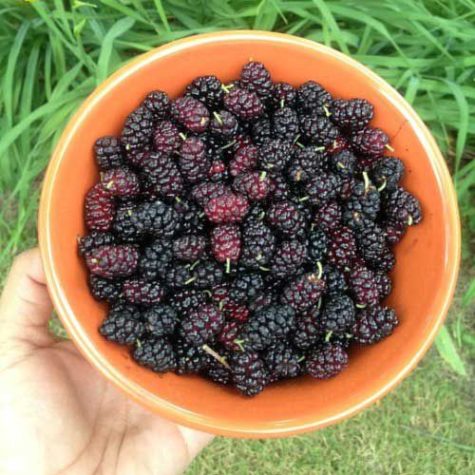
Collecting and Conserving
For all their deliciousness, Mulberries are delicate, perishable, labor-intensive to pick, and don’t all ripen at the same time. All of these factors contribute to the difficulty of commercially growing and harvesting these berries. They aren’t the kind of berry you’ll typically find in the grocery store, unless it’s a local specialty or gourmet outlet.
When they are ripe, you can harvest them by hand if you are lucky enough to have a tree. Place a tarp underneath the tree and gently shake the branches to loosen the ripe fruit. Some may come off, some may stay; they don’t all ripen at the same time, and some that are ripe may need a little coaxing off their stems.
The berries are very delicate and therefore need to be handled carefully so that they don’t break open – the stain won’t wash out.
Dried Mulberries are often sold at health food stores or natural, organic grocery chains, sometimes in the bulk section. They can also be purchased online in bulk.
- Storage
If you can manage not to eat them all, they’ll keep in the fridge for two to three days, unwashed, and in a covered container.
As the saying goes, when life gives you lemons, you make lemonade. And when Mulberry trees produce more fruit than you can consume, or perhaps you get lucky and score a surplus through your own devices (friends with trees, maybe?), you make jam. But there’s only so much you can make.
Here are some handy ways to conserve these first fruits of summer.
- Dry Them
Cover your dehydrator trays or a few window screens with these berries and dry them to create a sweet dried snack. For best results, apply a little Fruit Fresh or a similar vitamin C powder to discourage spoiling and spike the nutritional value.
Store the dried Mulberries in a breathable container like a paper bag, cloth sack, or wooden box to keep them from sweating and subsequently molding. Never eat any moldy dehydrated foods.
- Freeze Them
These berries will keep for six months in the freezer. Pop them frozen into smoothies or prep them in a yogurt-granola parfait in the fridge, where they can defrost and their color and flavor will naturally permeate the yogurt.
Mulberries are only in season for a few weeks in late spring and early summer. The fruit is used to make pies and tarts, as well as wines and cordials. But because of the berry’s brief season, we can only enjoy their slightly tart and refreshing taste for a short amount of time—unless we can preserve them for later use.
Freezing is the easiest way to preserve Mulberries, and whether you use fresh or frozen Mulberries, the results will be delicious.
Mulberries almost always come off of the tree with a little bit of stem attached. You can leave on the stem—it will not affect the berry—or, you can take the time to remove the stem bits before freezing. No matter, follow a few steps to ensure your Mulberries are easy to use when needed.
- Wash the Mulberries
Before placing in the freezer, you need to wash the Mulberries; washing removes bacteria that could be lurking on the berries, such as salmonella, E. coli, or norovirus. Run the berries under cool water and let them drain for a few minutes in a colander.
- Single-Layer Freeze
Freezing the berries in a single layer will ensure that the berries will remain separate once they are frozen. Spread the whole, washed Mulberries in a single layer on a baking sheet or on plates. Freeze the fruit, uncovered, for at least 2 hours.
- Transfer to Freezer Containers
Once the berries are frozen, you can transfer them to freezer bags or containers. (It is recommended that you use BPA-free, non-plastic freezer containers.) Make sure to label and date the bags or containers; you can store Mulberries in the freezer for up to 6 months. They are still fine to eat after that, but their quality and flavor degrade over time.
- Ways to Use Frozen Mulberries
There are many ways you can use the frozen Mulberries, from smoothies to baked goods to jam. You can blend straight-out-of-the-freezer Mulberries with milk (or a non-dairy alternative), yogurt, and honey or another sweetener of your choice. The frozen berries will give the smoothie a thick, cold, milkshake-like texture.
You can also add still-frozen Mulberries to pancakes, muffins, and quick bread. Although the Mulberries will cook along with the rest of the ingredients, berries that start out frozen in these recipes will not bleed their color as much as fresh berries tend to do.
Frozen Mulberries are just as good as fresh for making Mulberry jam and other sweet preserve recipes. Stockpile them in the freezer during the harvest season, and get around to that jam project later when you have time.
You can use the frozen Mulberries to make sorbet or ice cream, but you will need to thaw them before you transform them into a frozen dessert. You can also thaw frozen Mulberries and puree them to make a simple, flavorful sauce to spoon over yogurt, cake, or fresh fruit. If you think the sauce needs it, add a little honey or sugar and a small squeeze of lemon juice to intensify the Mulberry flavor.
Source: Encyclopedia of Herbology
Celery Juicing
Celery Juice
Plain, fresh celery juice is one of the most powerful healing juices available to us. This clean, green drink is the very best way to start your day. Make this juice a part of your daily routine and soon you won’t want to go a day without it!”
- Thoroughly rinse one bunch of Celery.
- Run it through a juicer.
- Drink immediately for best results.
- Makes about 16 ounces of juice.
If you don’t have a juicer:
- Chop the celery.
- Blend it in a high-speed blender until smooth.
- Strain well.
Here’s what Anthony William has to say about Celery juice:
Don’t let the simplicity of humble celery mask its strength—it’s often the simplest of measures in life that gracefully work wonders in the most complex situations. I believe that celery juice is a miracle juice and that it’s one of the greatest healing tonics of all time. I’ve seen thousands of people who suffer from chronic and mystery illnesses restore their health by drinking sixteen ounces of celery juice daily on an empty stomach. That’s why, long ago, I started the movement of drinking pure, straight celery juice. Since my books came out sharing the benefits of celery juice even more widely, it’s become a global movement. I want to be sure people know how to use this potent drink correctly and successfully because its healing potential is that tremendous.
Celery juice is most powerful when you drink it solo. While it’s great to consume other green juices or vegetables juices and add in items like spinach, kale, parsley, cilantro, and apples, drink those mixed juices at a different time than your straight celery juice. These blends function differently than what I’m recommending as your greatest tool for recovering your health: pure celery juice taken on an empty stomach.
- Eating vs. Juicing Celery: The Difference
Eating celery stalks, while very healthy and important, is not the same as drinking pure celery juice. When celery is juiced, the pulp (fiber) is removed, and I believe its healing benefits become much more powerful, especially for someone with chronic illness. You’ll also be able to consume far more celery as juice than you would by eating it.
I believe that celery juice also increases and strengthens your bile. Strong bile is important for breaking down fats; it’s also needed to eliminate waste from your body. In Liver Rescue, I share hundreds of what I call Liver Troublemakers, which are the specific chemicals, pollutants, pathogens, foods, and more that contribute to a sluggish liver, causing a wide range of health problems that result in chronic illness.
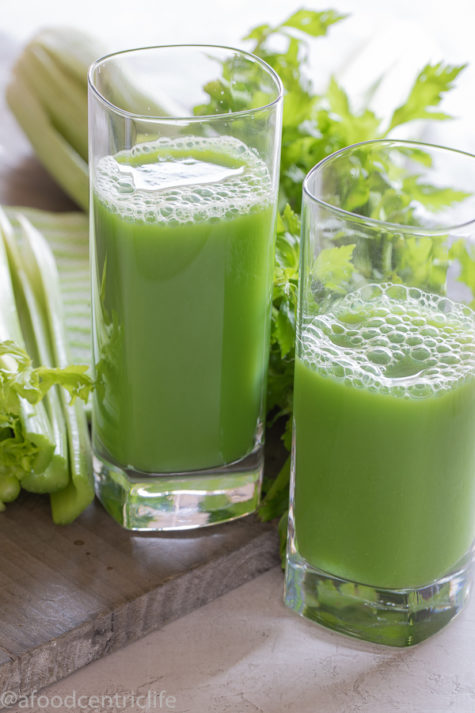
- Celery Juice Tips
Every morning, drink roughly sixteen ounces of celery juice on an empty stomach. Make sure it’s fresh, plain celery juice with no other ingredients. It takes roughly one large bunch of celery to make sixteen ounces of juice. Celery juice is a medicinal drink, not a caloric one, so you’ll still need breakfast afterward to power you through the morning. Simply wait at least fifteen minutes after drinking your celery juice before consuming anything else.
For even greater benefits or if you suffer from a chronic illness or symptom, consider drinking twenty-four to thirty-two ounces of straight celery juice per day. You can drink it all at once in the morning on an empty stomach or split it into two servings as directed below.
If you’re unable to consume your celery juice first thing in the morning before food, then the second-best option is to drink it fifteen to thirty minutes before or after eating something anytime during the day. If you’re having thirty-two ounces a day, you may wish to have it in two sixteen-ounce servings. You can drink the first in the morning on an empty stomach before eating and the second in the late afternoon or early evening, at least fifteen to thirty minutes before eating your next meal.
If you’re sensitive and sixteen ounces is too much, start with a smaller amount, such as two to eight ounces, and increase how much you consume over time. If you’re too sensitive for two ounces, you can try sixteen ounces of straight cucumber juice instead for now. Cucumber juice is very gentle, and you can try celery juice again once you’ve been drinking cucumber juice for a while.
Use organic celery whenever possible. If you’re using conventional celery, be sure to wash it especially well before juicing.
It is best to make celery juice fresh and then drink it immediately. If you’re unable to make your celery juice right before you want to drink it, it’s important to drink it within twenty-four hours of making it. The best way to store the juice is in a glass mason jar with a lid and keep it in the fridge. If you wish, you can also freeze celery juice and drink it as it defrosts. However, I believe the powerful medicinal properties of celery juice will decrease when it’s frozen, so it’s best to drink it fresh whenever possible.
If your mornings are busy, you can save time by rinsing the celery and chopping it (if needed) the night before so it’s ready for you to juice in the morning.
If you find the taste of straight celery juice too strong, you can juice one cucumber and/or one apple with the celery. This is a great option as you get adjusted to the flavor. As you get used to it, keep increasing the ratio of celery; I believe the greatest benefits come when celery juice is consumed on its own. This also means leaving out any lemon, lime, ice, or other added ingredients, all of which change the pure celery juice’s healing benefits. For the best results, think: straight celery. Also, if you find the juice bitter, it may be because of the celery leaves. Some people prefer to leave them on while others prefer to remove them. Both options are great; it’s an individual choice.
Some people may experience a change in their bowel movements when starting to consume celery juice. This is a normal reaction that some individuals may experience. The loose stools will pass as your body heals, and you may notice your bowel movements become more regular and healthier than ever.
Found at: Encyclopedia of Herbology
How to Make an Herbal Tea
The standard way to make an herbal tea is to pour slightly cooled boiled water over the material to be infused, let it stand for 5 minutes, strain it, and drink it. You can let it stand longer if you want stronger flavor. You can save the strained plant material for another cup of tea because as long as you get taste and color – it’s still good to use.
The reason why boiled water should be allowed to cool for 5 minutes before pouring it on the plant material is because boiled water can harm the nutrient levels. In particular, vitamin C is denatured at 158° Fahrenheit or 70° Celsius. The same goes for cooking foods containing vitamin C.
- Fresh plant material
When a recipe refers to fresh plant material to be used, a 1/8 cup fresh material is typically used in a large mug, (or a few leaves), following the method above.
- Dried material
When a recipe refers to using dried material, use 2 teaspoons of material when making it.
- Bark or seeds
Should the recipe call for bark or seeds to be used, use 2 teaspoons of seeds or 1 tablespoon of bark.
- Sweetening your infusion
You could sweeten your nourishing herbal drink with honey or cane sugar should you so require, and a dash of fresh lemon juice may also enhance the taste.
Note:
When making herbal teas – make lots! Use it to make your rice, quinoa or couscous. Use cooled tea to water your houseplants to give them added nutrients
Source: Edible Wild Food
Pine Needles ~ Benefits and Nutrients
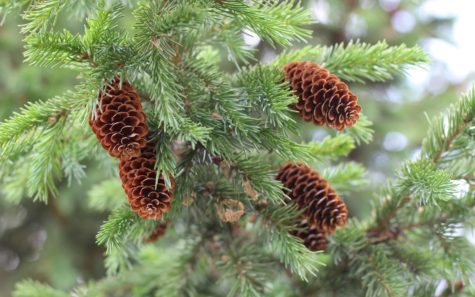
Pine needles range in size from 3 to 5 inches and are a deep forest green color. The long, thin needles vary slightly from variety to variety, depending on the region in which they grow. Pine needles have a strong pine scent, and a biting resinous flavor. In the wild Pine needles can be foraged year-round.
Foraged Pine needles can be used for a variety of applications. Pine needles are used most often for the oils and aroma within, to impart a pine scent or flavor to teas, ice creams, and liquors. Pine needles can be used like applewood or mahogany in fires to smoke meats or chicken, adding a hint of pine flavor. Place Pine needles under fish while cooking or chop like rosemary and add to marinades or brine. A variety of recipes can be found here.
Nutritional Value
It is said that Pine needles can be used as a natural remedy for up to 80% of human diseases. Pine needles are high in vitamin C; a tea made with the needles of the Pine tree has been used to stave off scurvy when no other sources of vitamin C were readily available. In a tincture or tea, Pine needles can help alleviate congestion and other respiratory problems. Components in Pine needles have decongestant, disinfectant and wound healing properties.
- Vitamin C Content
Pine needles purportedly have three to five times more vitamin C than an orange, depending on what source you read, but there’s no hard and fast rule for how much C is in a pine needle.
Regardless of the exact percentage, we know that pine needles and pine bark make an excellent natural vitamin C supplement. At least they’re potent enough to cure scurvy, a chronic condition caused by vitamin C deficiency that, left untreated, results in death.
One historical account relates the 1536 story of French explorer Jacques Cartier, whose crew was cured of scurvy with a tea of pine needles and bark given to them by the Iroquois after the crew suffered months of nutritional deprivation at sea.
Even though the crew boiled the decoction, which would have destroyed a significant portion of the vitamin C, there was still enough ascorbic acid and various amino acids to completely reverse their symptoms of scurvy.
It was such a dramatic change, the tree used for tea became known as “tree of life”. There’s no way to determine exactly what species it was, but we know the tree of life was a conifer. Eastern white pine is just one of the handful of candidates that could have been used.
The ascorbic acid (vitamin C) content of pine needles seems to vary significantly depending mainly on the species of pine and the age of the needles. The Eastern white pine needles of this USDA Forest Service study had between 0.72 mg and 1.87 mg of ascorbic acid per gram of pine needles.
New needles had the lower concentration, while 1 year old needles had 1.18 mg of vitamin C per gram of needles, and 2 year old needles had as much as 1.87 mg.
According to the USDA, 100 g of orange has 53.2 mg of vitamin C, or .532 mg/g. That puts pine needles at slightly more vitamin C for new needles, twice as much for 1 year old needles, and 3.5 times as much vitamin C for 2 year old needles.
The gist of the research is that ascorbic acid content increases with the age of the needles. Does that mean older needles are best for pine needle tea? Not if you’re after taste. Older needles make a stronger, bitter, more piney tasting tea, so if you want a milder, more delicate tea, look for brighter green young pine needles.
And don’t boil them. Boiling not only destroys vitamin C, but it also releases more terpenes–the organic compounds that make pine smell like pine–making more of a turpentine-like tea.
Other research indicates that balsam fir needles have significantly more vitamin C than white pine, so species matters, and the bark of white pine has more than needles. If you want a more potent brew of vitamin C, throw in some pine bark, although I can’t vouch for flavor, since I’ve never tried it.
Although there are several species of pine that make suitable tea, Eastern white pine (Pinus strobus) is one of the trees more commonly associated with pine needle tea, probably for its superior flavor.
Health Benefits of Pine
There have been a number of studies done on the nutritional qualities and healing powers of pine needles and bark. Here are just a few:
- Cancer prevention
(Antioxidant, antimutagenic, and antitumor effects of pine needles (Pinus desiflora)):
“These results demonstrate that pine needles exhibit strong antioxidant, antimutagenic, and antiproliferative effects on cancer cells and also antitumor effects in vivo and point to their potential usefulness in cancer prevention.”
- Cardiovascular health, antioxidant, immune function
(Comparison of methods for proanthocyanidin extraction from pine (densiflora) needles and biological activities of the extract):
“Flavonoids are known to be effective scavengers of free radicals. In particular, proanthocyanidins are flavonoids that possess cardiovascular protection, antioxidative activities, and immunomodulatory activities…In this study, we discerned an efficient extraction method to achieve relatively pure proanthocyanidins from pine needles and evaluated the biological functions of the resulting extract, which could potentially be used for its efficacious components in functional food products.”
- Potential treatment for anxiety, depression, and dementia
(Effect of new polyprenol drug ropren on anxiety-depressive-like behavior in rats with experimental Alzheimer disease):
“The obtained results…indicate that Ropren [a trademarked preparation based on extract of spruce and pine needles] is potentially active in the management of affective impairments in the experimental model under consideration. It also has a profound beneficial effect on the anxiety and depressive-like behavior in rats with model Alzheimer’s type dementia, and thus may prove to be a novel natural treatment.”
Dangers and Cautions:
Avoid pines that aren’t really pines. These include Yew pine (Podocarpus macrophylla) and Norfolk Island pine (Araucana heterophylla). And stay away from the highly toxic yew (genus Taxus).
Most sources warn of the potential dangers of pines like Ponderosa pine (Pinus ponderosa) and Lodgepole Pine (Pinus contorta), citing the possibility of abortion from drinking tea made with these species. And some sources say all pines could potentially cause abortion.
According to Green Deane Jordan of EatTheWeeds, pine needle tea drunk in moderation shouldn’t cause any problems unless you’re allergic to pine:
“The basis for this rumor is a veterinary study decades ago. If you are a cow and you eat many pounds of Ponderosa Pine needles you have a 5 to 8 percent chance out of 100 of having an abortion or still-birth. If you boil a huge amount of pine needles in water for hours down to a small amount of gross liquid and you drink it, then maybe it would cause an abortion. A few of needles soaked in hot water is no threat to anyone except for possible allergies.”
If you’re worried about it, stick with tried and true Eastern white pine, and of course exercise moderation.
Sources:
Evergreen Syrup
Spruce tip syrup used to be quite popular back in the day. It was used throughout Europe and by the pioneers in North America. Since Spruce tips grow in the spring, this syrup would have been a seasonal type of medicine. I generally make my evergreen syrup using needles and cones as these parts of the plant are most readily available, and have medicinal value as well.
Energetically, evergreens are super appropriate to use as medicine throughout the winter. Although most of the trees have lost their leaves by now, evergreens remain green, showing us that nature lives all year long. Evergreens are also helpful with the particular ailments that abound during the cold and dark season.
For the following recipe, I harvested from Norway spruce (Picea abies) and White pine (Pinus alba). Not the time of year for the tips so I used needles, twigs, cones. It turned out quite delightful with a predominantly sweet taste and evergreen-almost citrus undertones.
Evergreen Syrup Recipe:
- White pine needles, some twig ~2 oz weight (other pine species can be used)
- Spruce needles, 2 cones ~2 oz weight (other spruce species can be used)
- Filtered water to cover
- Honey- half of the amount of decoction that remains (a 1:2 ratio honey:decoction)
- Water added to evergreens
The weights are listed because I had them handy, however there is no set amount – it all depends on how much syrup you want to make. Put the plant material in a pot and cover with water. Bring this to a boil and then lower to simmer until the liquid is halved. I used a spoon as a measuring stick. You can also have a measuring cup handy to pour the liquid back and forth until it measures half of water added.
Reducing the decoction to half of the original liquid took almost ten hours. The liquid is then strained out, put back in the pot without the needles, and then the honey is added. The amount of honey to add is equal to half the amount of concentrate, so 8 ounces of concentrate would require 4 ounces of honey, or a 2:1 ratio. Warm and stir the mixture, and the syrup is done!
Medicinal Uses for the Syrup
Tree medicine is very powerful when grounding is needed. It fosters opening up to old wisdom, and letting oneself be cared for by the Earth. The evergreen forest is quiet, and feels limitless and mysterious. Evergreen syrup is good medicine for reflecting, meditating, and otherwise conjuring up introspective energy.
Decomposition of evergreen needles lowers the surrounding soil pH to provide a particularly acidic environment, a fact that I find interesting and relevant to its use as an antiseptic.
In Europe, pine products have been used as medicine since the Middle Ages, and their medicinal properties are pretty uniform across the Pinus genus. It acts as a stimulating antiseptic for respiratory infections and stuck mucus, and is useful for bronchitis, and at onset of colds and flu to stop infection. Pine is also used for coughs and asthma.
Spruce is useful to cut phlegm in the throat and lungs, and for opening air passages. It is high in vitamin C content, and can also be helpful for bladder conditions and in cases of leucorrhea.
Overall, Spruce and Pine syrup is great medicine to have on hand during the winter and early spring season. It can be used for acute illness, and as a winter tonic to provide a bit of sunshine in the form of a local source of vitamin C.
Evergreen syrup is also really tasty, making it an easy medicine to work with as it can be added to hot water, porridge, pancakes, or taken straight.
From: Herb Geek
Beautifying Raw Foods That Also Improve Immunity
Some of the most beautifying raw foods on the planet are also some of the best you can eat for optimal immunity, along with increased vitality and strength. That’s because many raw foods are high in minerals which are the micronutrients that your body absolutely must have for optimal health.
Without enough minerals, our skin, mood, and immunity all suffer greatly. They keep our bodies functioning on a deeper, cellular level, and the antioxidants found in many raw foods also help improve our beauty and defense mechanisms against various types of disease.
Several vitamins are also important for natural beauty and optimal immunity. So check out these 10 beautifying raw foods that are packed with nutrients that will improve your hair, skin, nails, immune system, and even your digestion and brain health too!
Pineapple
Would you believe that pineapple is one of the best sources of Vitamin C you can eat?
Pineapple’s Vitamin C content rivals that of most all fruits. The delicious sweet fruit contains over 100 percent of your daily Vitamin C needs along with high levels of the enzyme bromelain which helps break down proteins in the body. These properties not only improve digestion and immunity, but they also reduce acidity in the body which increases your body’s alkalinity to prevent inflammation.
Fresh or frozen pineapple is the kind of pineapple you’ll want to consume, though. Avoid the canned or dried varieties which have been more heavily processed and often have added sugars and/or oils. Use frozen or fresh pineapple in a smoothie, enjoy it as a snack, or pair it with a morning bowl of overnight oats if you like.
Camu Camu
Camu camu is a superfood that’s so beneficial for women that it’s even considered to be a medicinal herb in some cultures. The fruit comes from the Amazon and is the highest source of Vitamin C per serving on the planet. It’s also a good source of amino acids and several trace minerals.
Because of its high Vitamin C and amino acid content, camu berry is amazing for your skin, improving anxiety, and it can help aid in digestion. Camu camu also has antiviral properties which can help fight off candida and other fungal-related infections that demean your health.
The fruit is sold as a freeze-dried, raw powder here in the United States and it adds a sharp, tangy texture to smoothies. It pairs well with pineapple, banana, berries, and cacao, or it can be used in raw desserts, cookies, or added on top of a bowl of overnight oats. Just be sure not to heat camu camu since Vitamin C is heat-sensitive.
Raw Cacao
Speaking of cacao, it’s amazing for your health and beauty. Raw cacao is high in sulfur, a beauty-boosting mineral that also helps detoxify the liver.
Raw cacao is also high a potent source of antioxidants, flavonoids, and other minerals such as iron and magnesium. Cacao is even high in copper and zinc which improve your immunity and the strength of your blood.
Just be sure to go for the good stuff when you consume raw chocolate. You’ll want to avoid chocolate that is high in sugar and eat it raw and unsweetened, or choose dark chocolate with at least 90 percent cacao content. Or you can have raw, superfood chocolate—your choice.
Carrots
Like other orange-colored fruits and veggies, carrots are loaded with beta-carotene which is a precursor to Vitamin A, a natural beauty and immunity-boosting vitamin. Carrots are also one of the best sources of Vitamin C among all vegetables, and they’re high in water, fiber, and low in sugar.
You can eat carrots raw or cooked, but do be mindful most of the Vitamin C found in carrots is lost during the cooking process since Vitamin C is heat-sensitive. For this reason, to retain all the benefits carrots have to offer, be sure to eat them (and other fruits and veggies) in raw form whenever possible.
Carrots are also great for hormone balance, filling you up, and they can even be added to smoothies for a boost of nutrition and natural sweetness!
Acai Berry
Goji berries are an incredibly popular berry that’s great for your skin, and acai berry is another one of the top berries to consume for beauty and immunity. Acai berry is an Amazonian superfood that is a powerful source of omega-3 fatty acids which protect your brain, skin, heart, lungs, and your nervous system.
Acai is also a wonderful source of amino acids and several key minerals that improve your strength and immunity. It’s also low in sugar which makes it great for your blood sugar levels.
Acai fruit is sold as a raw, freeze-dried powder, so consume whichever you prefer. If it’s your first time using acai, pair it with blueberries and raw cacao where it takes on an especially lovely flavor.
Raw Almonds
Raw almonds are well-known for their high-protein content, but they’re also excellent for your skin. Almonds are a top food to consume to improve natural beauty because they’re rich in Vitamin E, magnesium, iron, zinc, copper, monounsaturated fats, and fiber, which slows down the release of insulin in your body.
Almonds also support collagen levels in the skin which can help to prevent and reduce fine lines and wrinkles. Almonds even improve the body’s response to stress, which can trigger inflammation if kept unchecked, and they’re alkaline foods when consumed in 100 percent raw form.
Dark Cherries
Dark, sweet cherries should be one of the number one foods you eat to beautify your skin and improve your immunity. Cherries contain dark compounds of antioxidants that promote longevity and decrease inflammation in the body and are very similar in nutrition to berries.
Dark cherries can be bought fresh or frozen, and they pair wonderfully with cacao, greens, berries, and other superfoods in a smoothie. Dark, sweet cherries can also decrease joint pain, improve sleep, and help protect the heart and skin from oxidative stress.
Romaine Lettuce
That’s right, one of the most simple greens that’s not kale is also one of the best you can eat! Sweet and hydrating romaine lettuce is incredible for your beauty and immunity because it’s one of the top sources of Vitamin C among all greens, it’s high in water to hydrate the cells, and it’s even a natural source of omega-3 fatty acids, believe it or not.
Use romaine in raw juices, smoothies, or make a huge salad with it and enjoy its naturally hydrating and beautifying benefits!
Pumpkin Seeds
If your skin and nails could use some help quickly, add some pumpkin seeds to your diet and consider yourself brand new! Pumpkin seeds are one of the best sources of zinc, protein and iron, three nutrients that improve skin health, blood sugar levels, immunity, and energy levels extremely quickly.
Pumpkin seeds can even improve your mood and blood sugar levels since they’re one of the best sources of magnesium among all nuts and seeds. And, they’re one of the best seeds you can eat to improve alkalinity due to their naturally high chlorophyll content.
Hemp Seeds
Hemp seeds are an incredible source of omega-3 fatty acids, they’re one of the best sources of iron and zinc you can eat, and they’re a complete source of protein making them great to consume in place of animal products. Hemp seeds are also a great source of chlorophyll which improves alkalinity, immunity, digestion, and the look of the hair, skin, and nails.
And of course, all raw fruits, vegetables, and greens are amazing for your beauty and immunity. Consume as many as you desire along with these 10 raw foods above, and enjoy the fall season with a greater sense of well-being and great skin too!
Article written by Heather McClees of The Soulful Spoon
Lecithin – An Amazing Youth Element
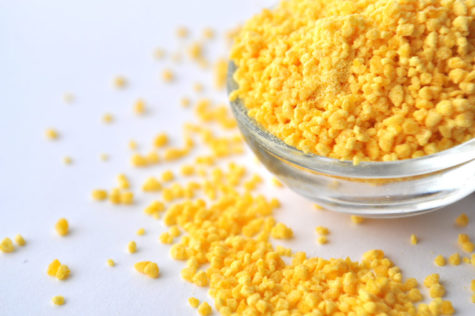
Lecithin is the most abundant of the phospholipids. It is a fatty food substance, which serves as a structural material for every cell in the body. It is an essential constituent of the human brain and nervous system. It forms 30 per cent of the dry weight of the brain and 17 per cent of the nervous system.
Lecithin is also an important component of the endocrine glands and the muscles of the heart and kidneys. It makes up 73 per cent of the total liver fat. Nervous, mental or glandular over activity can consume lecithin faster than its replacement. This may render a person irritable and exhausted. It is, therefore, of utmost importance to add lecithin to the diet, if the body’s own supply decreases as in old age or working under stress.
Rich Sources
Lecithin is derived from the Greek Word, likithos, meaning egg yolk. Egg yolk is a rich source of lecithin, and also a rich source of cholesterol. This combination makes it possible for the lecithin to emulsify the cholesterol. Vegetable oils, whole grain cereals, soy beans, liver and milk are other rich sources of lecithin.
The cells of the body are also capable of synthesizing it as needed, if several of the B vitamins are present. Since these B vitamins are generally removed when grains are refined, people who eat exclusively white flour products are lacking them.
Benefits
The action of lecithin on the heart is the most important of all its proved benefits. It achieved its popularity initially in this area. Cholesterol is a fatty substance that tends to collect in the walls of the arteries and veins, thus narrowing them. This may eventually lead to a fatal blood clot. Scientific studies have shown that lecithin has the ability to break up cholesterol into small particles which can be easily handled by the system. With sufficient intake of lecithin, cholesterol cannot build up against the walls of the arteries and veins.
Like cholesterol, lecithin is continuously produced in the liver, passes into the intestine with bile and is absorbed in the blood. It helps in the transportation of fats. It also helps the cells to remove fats and cholesterol from the blood and to utilize them. It increases the production of bile acids made from cholesterol, thereby reducing the amount in the blood. It will thus be seen that cholesterol can cause trouble only if lecithin is lacking in the system.
All atherosclerosis or changes in the arterial walls are characterized by an increased of the blood cholesterol and a decrease in lecithin. It has been shown that experimental heart disease, produced by feeding cholesterol, could be prevented merely by giving a small quantity of lecithin. Atherosclerosis has been produced in various species of animals by increasing the blood cholesterol or decreasing the lecithin.
In normal health, when a diet high in fat is taken, there is tremendous increase in the production of lecithin. This helps in changing the fat in the blood from large particles to smaller and smaller ones. In case of atherosclerosis, however, the lecithin in the blood remains very low regardless of the quantity of fat entering the blood. The result is that, the fat particles remain too large to be able to pass through the arterial walls.
A more serious situation can develop if there is lack of lecithin in cells also. Besides reducing the cholesterol level in the blood, there is mounting scientific evidence to suggest several other benefits from lecithin. It has been suggested that its intake in sufficient amounts can help rebuild those cells and organs which need it. Lecithin helps to maintain their health once they are repaired. It may mean that a deficiency of lecithin in the diet may be one of the causes of ageing and that its use may be beneficial in retarding the ageing process.
Edward R. Hewith in his book, The Years Between 75 and 90 says:
” with older people the fats remain high in the blood for from five to seven hours and in some cases as long as 20 hours, thus giving the fats more time to become located in the tissues. If lecithin is given to older people before a fatty meal, it has been found that the fats in the blood return to normal in a short time, in the same way they do in younger people.”
In some cases, the cosmetic effect of lecithin does as much for the mental outlook of persons as it does for their physical well-being. It has been found to eliminate the yellow or yellow- brown plaques on the skin or around the eyes caused by fatty deposits. It is a natural tranquilizer which is beneficial in nervous exhaustion. It can produce great alertness in elderly people.
Some studies have indicated that lecithin increases the gamma globulin in the blood. This helps fight infection. It provides an increased immunity against pneumonia. It has also been found to lower blood pressure in some people. In combination with vitamin E, it has proved helpful in lowering the requirements of insulin in diabetics. It has also proved valuable in the treatment of certain skin ailments, including acne, eczema and psoriasis.
Lecithin has been suggested as a sexual aid. It was used in Germany 30 years ago as a restorative of sexual powers, for glandular exhaustion and nervous and mental disorders. Seminal fluid is rich in lecithin. Because of its loss from the body, its need for men is regarded as specially great. Its use is also considered valuable in minimizing pre-menstrual and menopausal tension.
Dr. N.A. Ferri, an eminent physician remarks:
“Lecithin has a versatile function in life. It is an extremely important factor in the digestion and oxidation of fats, thus creating more muscle and glandular activity, resulting in greater body exertion and less fat accumulations.
Lecithin is essential not only for tissue integrity of the nervous and glandular system in all living cells, but has been regarded as also the most effective generator and regenerator of great physical, mental and glandular activity.
Shattered nerves, depleted brain power, waning activity of vital glands, find in lecithin, especially in the cellular structure of the nervous system and endocrine glands a source of dynamic energy.”
The best way to increase lecithin is to eat the same amount of fat as usual, but reduce animal fat except that from fish. Oil may be used for cooking, seasoning and salad dressing. All hydrogenated fats such as margarine, cooking fats, hydrogenated peanut butter and processed cheese should be avoided as also foods prepared with them.
More About Buckwheat
Here’s a great little article about Buckwheat from Jen Reviews. Buckwheat has often had a dull reputation associated with it, particularly because its flavor is somewhat lacking and it is a healthier option that requires more effort when being prepared. It is also not as readily available as other harmful, fatty snacks and meals may be.
As we strive to eat more nutritiously, and as we uncover seemingly increasing harmful effects of processed flours and grains, it’s good to know that nutty, wholesome, healthy, grain-like alternatives such as buckwheat exist.
Below is a list of the top 14 benefits of buckwheat:
Buckwheat is Not a Grain
Nutritionally, grains are unnecessary and can even be deemed as harmful, particularly because they can damage the digestive tract, are high in caloric content, and reduce the absorption of calcium.
As a result, avoiding grains is a popular dietary option. Fortunately, buckwheat, often mistakenly listed as a grain, is actually a pseudocereal– or fruit seed– that comes from the Polygonaceae family. Consumed in either flour or its pure form, buckwheat is most closely associated with other pseudocereals, such as quinoa.
Pseudocereals are not grasses, while true cereals are. Pseudocereals are plants that product suides or fruits that are consumed, prepared, and used as grains. They are usually very high in protein and other essential nutrients. They are also naturally gluten-free.
Therefore, buckwheat is not quite an actual cereal, but its nutritional values and usage diversity makes it comparable to not only cereals, but grains, millet, rice, and barley as well.
As a result, it can often be treated, cooked, and prepared in similar manners. It can typically be factored into recipes that call for these comparable ingredients.
The grain-like way that it is soaked– often for long periods of time or overnight– and cooked can undoubtedly be deceiving, leading some to believe that it is a grain.
Believe it or not, it’s actually not a form of wheat either. The portion of buckwheat that is edible derives from a plant related to rhubarb and sorrel.
It is, indeed, a seed.
Bottom Line: Buckwheat is a seed, not a grain or a wheat. If anything, you should go out of your way to consume it for its benefits, rather than mistakenly avoid it!
Buckwheat is Chemical-Free
On its own, buckwheat grows efficiently and quickly. A likely contributor as to why it is a popular global crop, harvest occurs just 10-12 weeks after plantation.
As a result, it does not require the same attention, pesticides, and maintenance that other seeds may in order to enhance growth, leaving the seed clean of potentially harmful additives.
Pesticides, though used to deter pests from the growth of crops, have also been known to kill innocent, beneficial insects, fish, birds, and other plants. Limiting the use of pesticides is not only favorable for the ultimate consumer of the crop, but for the environment and flourishment of other beings, plants, and crops as well.
Additionally, while buckwheat flowers have been known to keep the honeybee population flourishing with their morning nectar, they also support the existence of smaller insects, particularly hoverflies.
The buckwheat crop itself keeps pests that are attracted to other crops at bay, ensuring that potatoes, broccoli, and other vegetable crops remain untouched. Buckwheat simply needs to be grown within 20 feet of said crops in order to be effective.
Groats, the correct term for buckwheat “grains” or buckwheat hulled seeds, are reliable, successful crops that can endure both cool and dry climates, acidic soils, and unpredictable weather. Over time and particularly in Tibet, buckwheat has even been known to grow at altitudes higher than other cultured plants. Late spring and summer crops will grow taller than those planted any later.
Although it technically grows best in warmer weather, buckwheat’s durability has contributed to its common plantation across cooler climates in the United States, Russia, and China.
As a bonus, it can also be used as a cover crop to reduce weeds. Buckwheat seeds can be purchased by most companies that sell cover crop seeds, but farm supply and health food shops also provide a decent selection.
Bottom Line: Buckwheat is packed with nutrients, not chemicals, and it reduces the need for harmful pesticides.
Buckwheat is a Great Source of Fiber
Buckwheat seeds, also known as “groats,” are full of dietary fiber, both soluble and insoluble. Insoluble fiber, unlike soluble fiber, does not dissolve in water. Soluble fiber is found not only in buckwheat, but also in oats, barley, beans, and lentils. Insoluble fiber can be found in nuts, seeds, and other whole-wheat foods.
Foods rich in dietary fiber protect us from various cancer diagnoses– including cancers of the esophagus, rectum, colon, stomach, and mouth– among other diseases.
Adding fiber to your diet also helps you feel full, increases the density of stools, dilutes harmful substances, and expedites their elimination from the body. The high fiber content in buckwheat is said to lower blood sugar levels following meals.
Bowel movements are more frequent as increased fiber intake prevents constipation and helps create a clear tract.
Just one cup of buckwheat contains 17 grams of fiber, closely amounting to the 25-30 grams recommended per day. As a result, groats are commonly categorized as “superfoods.”
Its high content of fiber eliminates the need to otherwise ingest other high-fiber fruits and vegetables. In fact, five servings of vegetables and fruits plus three servings of whole grains would have to be ingested to reach the 30-gram-per-day fiber recommendation.
Ironically, buckwheat is also used to treat diarrhea. However, buckwheat should be avoided by overly sensitive individuals, such as those with IBS (irritable bowel syndrome) or Crohn’s disease. The seed can either help or exacerbate symptoms and could cause gas and cramping.
One should also be careful to slowly but surely increase one’s intake of fiber, and therefore buckwheat, as too much too quickly can surely result in abdominal discomfort. However, drinking plenty of water is a perfectly acceptable motion to eliminate such.
Bottom Line: Buckwheat is abundant with fiber.
Buckwheat is Gluten-Free
Despite its misleading name and as noted previously, buckwheat is not actually a wheat, nor a grass. Since it’s naturally gluten-free, buckwheat is a perfectly acceptable alternative to barley, oats, rye, and wheat, thus making it preferred to those who are allergic to any of these elements.
Gluten has been deemed harmful for numerous reasons and it has recently been purposely avoided whenever possible as a result. It has been shown to cause asthma, vitamin B12 deficiency, excessive weight gain or loss, and it has been directly linked to the causes of up to 200 other medical conditions.
Gluten is also commonly a cause of dizziness, thyroid disease, skin disease, loss of balance, neuropathy, and nerve pain. It has been linked to the development of certain skin diseases.
It can also trigger testosterone issues in men, migraines, and liver damage. Gluten can also cause inflammation of the gut, otherwise known as “leaky gut,” leading to intestinal permeability.
This is significantly harmful because intestinal permeability disrupts the gut’s natural ability to filter out harmful items that we ingest on a daily basis, such as dust, viruses, and bacteria. If the gut fails to filter these items through the intestinal tract and out the other end of the body, they will be absorbed into the bloodstream.
The damage gluten can do to the body does not stop in the gut. Believe it or not, gluten can also affect the functionality of your brain. As a direct result of the gut inflammation and other microbiome disturbances caused by gluten consumption, your vulnerability to brain-related diseases such as dementia and Alzheimer’s disease is significantly increased.
If only for the sake of avoiding gluten, buckwheat is an admirably healthy seed for the body.
Bottom Line: Buckwheat is ideal for those seeking gluten-free foods, or those who suffer from other wheat and grain allergies.
Buckwheat Helps Prevent Cancer
Since the consumption of fiber is one of the leading ways to reduce your chances of being diagnosed with colon cancer, it’s evident that buckwheat indirectly contributes to the prevention of cancer, particularly colorectal cancer.
Buckwheat’s high fiber content also protects the digestive organs from cancerous cells and fights other various cancers of the mouth, esophagus, and more.
The increased fiber not only keeps your intestinal tract healthy and clean, it also fights the production of breast cancer cells and gallstones in women.
In cancer patients, buckwheat has been shown to alleviate the effects associated with radiation and chemotherapy.
As a bonus and perhaps only cosmetically, buckwheat consumption also contributes to the prevention and reduction of varicose veins, which are often abundant in aging women.
Varicose veins are swollen, stretched, dark-colored “road maps” that usually cover the entirety of the legs. These veins appear when those surrounding the thighs or calf muscles are inflamed and can no longer close properly. This results in unfavorable blood flow to the heart.
If left untreated, varicose veins can lead to ulcers, blood clots, and other harmful complications. Buckwheat’s safe, wholesome, and antioxidant profile makes it an ideal natural solution to this condition.
Bottom Line: The consumption of buckwheat can help prevent various types of cancer, as well as gallstones.
Buckwheat is a Good Energy Source
Studies done on pigs have shown that buckwheat, when combined with wheat and oats, is more effective in terms of increased energy than sweet potatoes. It’s thought that the vitamins in buckwheat, particularly Vitamin B, greatly contribute to its energy benefits.
Buckwheat groats are healthy carbohydrates. The human body captures the carbohydrates in superfoods such as buckwheat and turns them into energy. Energy supports overall bodily functionality and physical exertion.
It’s healthier for the body to be energized naturally than it is to be aided with chemical components such as caffeine. Unnatural substances such as this can cause side effects like insomnia, irritability, increased heart rate, and more.
Almost the direct opposite of using buckwheat as an energy source, caffeine is linked to the raising of blood pressure, gout attacks, breast cysts in women, incontinence, indigestion, headaches, reduced fertility, and miscarriage.
Indirectly, caffeine is associated with worsened menopausal symptoms in women, increased anxiety and depression, increased sugary beverage consumption, toughened recovery from hearing loss, and a greater risk of fractures of the bones.
Those who rely on caffeine as an energy boost often complain of tremors, irregular heartbeat, hallucinations, and adrenal fatigue.
In its simplest comparison, caffeine is a drug while buckwheat is a natural crop easily grown without the use of pesticides.
As a bonus, buckwheat is an incredible ingredient in the recipes for some teas. Buckwheat flowers tea heals the respiratory system and lungs, aiding in the reduction and prevention of cough, mucus, and more. Atherosclerosis– or the disease of excessive plaque build-up– of the blood vessels is also aided by the combination of leaves and flower.
Truly, a tea made up of both buckwheat and limited levels of caffeine would certainly work wonders for those seeking a boost throughout their day!
Bottom Line: You can trade in caffeine and energy boosters for the natural effects of buckwheat.
Buckwheat Lowers Blood Pressure and Cholesterol
Rutin is a bioflavonoid and is abundantly found in buckwheat. The plant pigment can be found in apples, citrus, figs, and certain types of tea, in addition to buckwheat.
Rutin not only acts as an antioxidant that helps your body use vitamin C and produce collagen, it also counteracts high blood pressure. Consuming rutin in buckwheat form eliminates the need to take it as a supplement.
Rutin is crucial to the support, growth, and strength of tiny blood capillaries. Rutin also reduces glycosylated hemoglobin and fasting glucose in diabetic patients.
The element also improves blood circulation and therefore, as discussed previously, reduces the inflammation associated with damaged veins. This was proven by the reduction of inflammation across various test tube studies, as well as in the results that stemmed from rat models suffering from chronic arthritis.
Rutin has shown in studies to be one of the most potent anti-clotting compounds of those tested. It blocks clot formation, therefore reducing the risk of stroke and heart attack. Buckwheat is one of the most potent sources of this ingredient.
Bottom Line: One the main ingredients in buckwheat, Rutin, contributes largely to the functionality of the cardiovascular and glucose components of the human body.
Buckwheat is Great for Weight Loss
Due to its high fiber content, buckwheat fills you up quickly and suppresses your appetite. Buckwheat undoubtedly contributes to weight loss as a result. Compared to barley wheat, it is low in calories and is even considered a healthy source for such. As a result, buckwheat is common in vegan lifestyle recipes.
In fact, a two-week, cheap, and ever-increasingly popular and fashionable “buckwheat diet” has actually been said to make losing 10-20 pounds completely possible. Because of its quickness and effectiveness, the diet is popular in the new year and immediately following the holiday season that typically causes so many to pack on some extra pounds.
Although undoubtedly effective, “the buckwheat diet” is based on eating only specially cooked buckwheat and is therefore only intended for the strong-willed with effective self-discipline.
Sixty percent of those who have tried it among others have claimed “the buckwheat diet” to be most effective, considering it not only affects weight loss but also aids in body cleansing.
The diet has been popular across many European countries in recent years. Those who decide to try the diet often consume just water, certain fruits, and green tea in addition to the seeds. The usage of kefir, a specific type of buttermilk, is also encouraged in the diet. Strict buckwheat dieters also avoid consumption of anything after 6 PM each day and alcohol is entirely eradicated.
However, it is challenging to consume merely buckwheat throughout the day, especially without the use of unhealthy additives that make its consumption tastier, such as seasonings or butter.
Although buckwheat is low in calories compared to other wheats and barley, its overall calorie content is actually somewhat high, and therefore it should not be relied upon as a full daily meal replacement in an effort to lose weight. It should merely be utilized as a supplement to an overall healthy daily diet. Fortunately, “the buckwheat diet” recognizes this and is only short-term and cannot even be repeated until a full month has passed since the last one.
Feeling hungry is a key contributor to other failed weight loss plans, which can be avoided with the consumption of buckwheat.
Buckwheat is also completely free of saturated fat and incredibly low in actual fat, totaling just 0.6 grams in one half cup.
Bottom Line: The consumption of buckwheat leads to increased weight loss.
Buckwheat Fights Water Retention
Otherwise known as “bloating,” water retention occurs throughout the body, typically through the swelling of the feet, face, hands, or legs. Bloating is also characterized by an abnormal increase in the abdomen diameter.
Often encountered by those who work out, especially those who are just beginning to work out, water retention can be caused by new stress and motioning of the muscles.
Water retention, or bloating, can be reflected on the scale, even though it only represents water weight. Increased intake of both salt and sugar can also lead to water retention.
It can be tempting to drink less water when fighting water retention, but a decreased fluid intake will cause the body to literally hold on to the fluid it is already retaining. Added fluids will aid in good kidney function and allows the body to release what is being held.
Both alcohol and caffeinated drinks have been found to lead to dehydration and fluid retention.
Those who experience bloating in its truest form often complain of a gassy feeling, cramping, and stomach growling.
Also a common side effect of menstrual periods in women, bloating can be alleviated only by time or by flavonoids, such as those contained in buckwheat. Flavonoids support and strengthen the functionality of the lymphatic vessels, which regulate fluid retention in the human body.
- Bottom Line: Buckwheat naturally alleviates water retention and bloating.
Buckwheat is Great for Culinary Purposes
Just as Bubba could note all the things that could be done with shrimp in the movie Forrest Gump (“shrimp burger, shrimp sandwich, that’s about it…”), buckwheat can be incorporated into countless food and drinks, including pasta, pizza, crepes, noodles, pancakes, bread, and more.
In its most basic form, you only need to add cardamom– the aromatic seeds that stem from the ginger family– and liquid stevia (or another preferred sweetener) in order to consume a tasty batch of buckwheat. You can even add fruits or nuts if so desired.
There are other basic, traditional ways to cook buckwheat with hot liquid: absorption, streaming, and boiling, or a combination of any of these.
Boiling is probably the simplest method of cooking buckwheat. Cook uncovered in a large pot of water and then drain to remove excess moisture.
Absorption is the more common method. It requires a much more specific quantity of water in ratio to the amount of buckwheat. It often requires guessing and checking, but does not cause excess moisture to occur.
Streaming is least practiced due to its time consumption. It requires the boiling of some grains briefly before streaming and soaking others.
In order to cut down on any cook time, you can always purchase pre-sprouted buckwheat.
No matter which method you elect, just take note as to how much syrup or other goodies are added to enhance your buckwheat recipe so as to not counteract its wholesome benefits!
Buckwheat is often served as an alternative to rice or porridge.
It’s also a powerful option for blending tea and can also be used in the creation of gluten-free beer and whiskey.
Bottom Line: It can be incorporated into everyday meals and beverages, making its consumption easier to achieve.
Buckwheat is Full of Vitamins
Buckwheat is made up of a high level of amino acids and powerful vitamins such as manganese, magnesium, and copper.
Increased copper intake prevents neurodegenerative diseases, while increasing your zinc boosts your immune system and keeps illness at bay.
It’s also full of Vitamin B, which contributes to the overall well-being of your skin, organs, memory, and hair.
Specifically, buckwheat contains the vitamin-B complex, which is made up of eight different B vitamins: B1, B2, B6, B7, B12, B9, B3, and B5. These nutrients convert what we consume into energy and fuel.
Separately, these vitamins are responsible for creating new healthy cells, working as antioxidants, boosting cholesterol, producing hormones, regulating amino acids, controlling glucose, deterring and preventing depression and memory loss, producing red blood cells, and creating hemoglobin.
Additionally, one of the B-complex vitamins contained in buckwheat is folic acid. Women are encouraged to take folic acid supplements throughout pregnancy since it significantly diminishes the risk of birthing a child with defects.
Bottom Line: Eliminate the need to take certain vitamins by increasing your buckwheat consumption.
You Can Sleep On It
No, really! As opposed to utilizing a soft, cushy pillow that fails to support your neck and therefore good posture, you can opt to fill your pillowcase with buckwheat. Some benefits include keeping your neck in an ergonomic position without collapsing, preventing neck sweats, and the fact that they last for more than 10 years.
Buckwheat-filled pillows are popular throughout Asia. They are said to promote more restful sleep.
Because of their crunchy and hard texture, it’s tough to imagine how buckwheat hulls can be comfortable, but health, posture, and overall well-being are prioritized above comfort with this pillow-stuffing method.
It is believed that buckwheat-filled pillows can also alleviate headaches, neck pain, and back pain. They are also said to resist dust mites.
Neck sweats are eliminated since the hulls are breathable.
The malleable quality of a buckwheat pillow enables support for your neck, allowing the spine to remain straight and your muscles to relax. The pillows have also aided in the prevention of insomnia, allergies, snoring, and sleep apnea.
As a bonus, you can add or remove hulls from the pillowcase to suit your comfort level.
Some drawbacks from actual buckwheat pillowcase users include a high level of noise, too small in size, too heavy compared to cotton pillows, and expensiveness.
The decision to invest in buckwheat pillows would have to depend on your sleep-related priorities.
Bottom Line: In addition to its nutritional benefits, buckwheat is also a winning option in its physical form, as is evidenced in its role in supporting the neck while sleeping.
Buckwheat is Actually a Comfort Food
Technically, buckwheat is a yang food, which is considered “warm.” It earns this categorization because it is high in protein and shrinks when cooked.
Comfort food is defined by meals prepared traditionally that evoke a nostalgic or sentimental feeling from its consumers.
Unfortunately, some of us are quick to grab unhealthy versions of comfort food when we’re feeling down. These foods do not qualify as yang foods. Some unimpressive options include fattening snacks like chips, chocolate, or ice cream.
The fatty acids in these selections actually give our emotions a positive boost, which is why we often refer to them first.
Fortunately, buckwheat can be used in the creation of wholesome thick, filling, warm meals such as creamy pastas, pancakes, warmed muffins, cookies, soups, and crepes.
Therefore, it’s a good option for consumption in those long winter months and is a reliable, alternative, wholesome option to those unhealthy snacks that otherwise make us feel so good.
Beyond its attributes to the health of the human body, buckwheat is also beneficial to our mental and emotional well-being.
Because of its wholesome qualities and versatile usage, it is commonly used across comfort foods in various cultures, such as Jewish, Asian, and Russian.
Bottom Line: Buckwheat is good for you all year long, but will probably mentally taste better in the winter months.
Buckwheat is Rich in Protein
Foods with high levels of protein are widely used for healthy eating. Though there are pros and cons to high protein diets, they, for the most part, work.
The human body also uses protein to both repair and build tissues. Protein is also used in the production of hormones, enzymes, and other various body chemicals. Most aspects of the body– from bones to cartilage to skin to muscles to blood– use protein as a building block.
Because the body relies so heavily on protein, it’s crucial to ensure your intake of such is quite high, an effort that can undoubtedly be aided by the increased consumption of buckwheat.
Unlike carbohydrates and fats, protein is not stored for later by the body, and therefore it has no supply to reply upon when needed. Therefore, it is imperative to consistently replenish your internal protein supply.
Though not as admirable in terms of the high protein in quinoa, legumes, or beans, buckwheat contains 11-14 grams per every 100 grams.
Bottom Line: Buckwheat is packed with the high level of protein necessary to maintain a healthy diet.
If buckwheat is not currently being adapted into your diet, it would be a good decision to slowly– but surely– add it in. The mental and physical advantages to the increased intake of buckwheat are innumerous. Its tremendously healthy compounds have proven to be direct preventatives of some majorly concerning diseases. A natural, safe, easily-grown and accessed pseudocereal such as buckwheat deserves more space in your everyday diet, as it will fully support your overall functionality, weight loss ability, and well-being.
Article by Jen Reviews
The Other Side of the Banana Story

Yes, bananas are good for what ails you, but life on a banana plantation – growing Chiquita bananas means pesticides and hard work.
On farms from Mexico to Ecuador, Chiquita and its affiliates grow millions of bananas every year for consumers in North America and Europe. The fruit is grown and harvested in a labor-intensive process that involves an army of workers, lots of equipment, crop-dusting airplanes, foam cushions, string, bags, special cartons, refrigerated trucks and trains, and tons of pesticides.
While production methods vary slightly from plantation to plantation, the basic operations described below remain the same. This example is a composite plantation, drawn from Enquirer reporters’ visits to Chiquita subsidiary plantations and Chiquita-affiliated farms in Honduras and Costa Rica, as well as interviews with plantation workers and environmental scientists.
A Commercial Banana Operation
Commercial banana plants grow from 15 to 30 feet in height and are grown in long rows on large irrigated plantations. Most bananas consumed in the United States are grown in the lowlands of Central and South America.
The average banana plant produces fruit about every nine months. The stem usually grows to contain about 150 bananas. When the manager decides, the fruit is cut green from the plant and dropped carefully on the back of a worker carrying a cushion to stop any bruising of the fruit.
To kill off other plants growing around the bananas, workers apply herbicides. The chemicals are toxic and wash into the ground and ground water during rains.
To kill off nematodes, small worms that attack banana plants from the roots, workers cover the ground around the plants with nematicides. These chemicals are highly toxic and make an area extremely dangerous for 24 to 48 hours after application.
Banana plants do not have strong trunks, they can easily be knocked over in a tropical windstorm. To prevent ‘blowdowns,’ workers tie the plants down with string.
Aerial spraying is an integral part of pesticide application in commercial banana farming. The main purpose is to combat Black Sigatoka, an airborne fungus that can destroy a plantation’s crop. In areas that are infected with the fungus, including much of Central America, airplanes may spray fields more than 40 times a year.
The spray lands on the plants’ upper leaves, the ground, irrigation canals, streams and rivers and nearby homes, workers and residents, scientists told the Enquirer.
Workers on Chiquita subsidiary plantations and other farms producing Chiquita bananas told the Enquirer that they receive no warning when the planes come over and they often hide under banana leaves to escape the pesticide dust.
Nearby villagers complain the aerial spraying often drifts into their yards, sending children running into the houses to escape rashes. Many worker villages are located close to banana plantations.
The water used in the in the packing plants to wash pesticides off the bananas comes from the irrigation canals and then is routed back out into the water supply. Chiquita has built berms in recent years on some plantations to limit pesticides from flowing directly into rivers. But many irrigation canals, laced throughout every plantation, remain directly exposed to pesticides.
Plastic bags embedded with the powerful chemical chlorpyrifos protect the the growing fruit from insects throughout its entire gestation. In previous years,the bags were simply discarded after use, though the major banana companies have now started recycling programs.
At harvesting, the stem is placed on a large overhead cable system that runs throughout the plantation. Workers place foam cushions among the fruit to stop bruising. The fruit is then pushed along the cable toward the “Empacadora,” the packing plant.
In the packing plant, workers remove the cushions. Other workers then cut the stems into smaller bunches.
The bunchesare then put in a “pila de seleccion,” a selecting trough, where selectoras, usually women, choose the bananas and cut them further down to shipping size with small hooked knives.
Larger troughs called ‘pilas des leches,” milk troughs, wash off the pesticides applied in the fields as well as natural fluids from the banana plant.
New pesticides are applied to the bunches after they are placed on a conveyer belt. The new pesticides, either thiabendazole or imazalil, are applied to prevent “crown rot,” a fungus that attacks the extremities of the banana bunch.
On some plantations, Chiquita has installed small plastic containment systems that save money on pesticide costs and reduce worker exposure to the pesticides. But most plantations do not have this system, according to Chiquita statements issued through its attorneys to the Enquirer.
Boxes of banana bunches, freshly applied with pesticides, are put on large skids for shipment. On all the plantations visited by the Enquirer, most workers viewed by reporters did not wear gloves when handling the pesticide-covered bananas.
Trucks or trains are brought to the plant and loaded with the skids. The bananas are taken to port, where the large refrigerated containers are lifted onto ships. The ships then sail to various destinations, usually in North America or Europe. About ten days to two weeks after being harvested, the bananas are on display and for sale at local groceries.
Pesticides in the banana ecosystem
The ecosytem of a banana plantation is extremely wet and hot. The soil is very loose, helping the banana plants grow but also making it easy for pesticides to spread throughout the system.
It often rains in these areas, flushing pesticides into the ground and water table. The banana industry’s answer to this dissipation has been to apply pesticides frequently.
Ways pesticides get into the environment:
Air: Airplanes drop toxic chemicals regularly from the air. Pesticides fall on the plants, but also on workers, the ground and irrigation canals and streams.
Ground: Workers apply pesticides to the ground around the plants. These chemicals seep into the ground with every rainfall.
Water: Pesticides also get into water that is used to wash bananas in the packing plants. That water then flows back into the irrigation canals.
Bags: Plastic bags with the insecticide chlorpyrifos cover all the banana bunches from their inception. The chemical leaks off the bags in rain storms and flows into the ground and water.
Black Sigatoka is a banana plant disease that plagues most areas where Chiquita bananas are produced. The airborne fungus eats away at the plant leaves, turning them black. The disease shrinks the size of the fruit and makes it ripen too quickly to be shipped to market. Eventually, the disease kills the plant. Some researchers are now trying to find a Sigatoka resistant banana that will still appeal to consumers, but nothing has been discovered thus far. To date, the industry’s reaction to the problem has been to increase aerial spraying of powerful pesticides.
BUY ORGANIC!
Good For You, good For the Planet.
Going Bananas!
Finally a cure for what ails you – Bananas! A professor at CCNY for a physiological psych class told his class about bananas. He said the expression ‘going bananas’ is from the effects of bananas on the brain.
- Important:
Never, put your bananas in the refrigerator!!!
After reading this, you’ll never look at a banana in the same way again.
Bananas contain three natural sugars – sucrose, fructose and glucose combined with fiber. A banana gives an instant, sustained and substantial boost of energy. Research has proven that just two bananas provide enough energy for a strenuous 90 minute workout. No wonder the banana is the number one fruit with the world’s leading athletes.
But energy isn’t the only way a banana isn’t can help us keep fit. It can also help overcome or prevent a substantial number of illnesses and conditions, making it a must to add to our daily diet.
Depression: According to a recent survey undertaken by MIND amongst people suffering from depression, many felt much better after eating a banana. This is because bananas contain tryptophan, a type of protein that the body converts into serotonin, known to make you relax, improve your mood and generally make you feel happier.
PMS: Forget the pills – eat a banana. The vitamin B6 it contains regulates blood glucose levels, which can affect your mood.
Anemia: High in iron, bananas can stimulate the production of hemoglobin in the blood and so helps in cases of anemia.
Blood Pressure: This unique tropical fruit is extremely high in potassium yet low in salt, making it perfect to beat blood pressure. So much so, the US Food and Drug Administration has just allowed the banana industry to make official claims for the fruit’s ability to reduce the risk of blood pressure and stroke.
Brain Power: 200 students at a Twickenham (Middlesex) school were helped through their exams this year by eating bananas at breakfast, break, and lunch in a bid to boost their brain power. Research has shown that the potassium-packed fruit can assist learning by making pupils more alert.
Constipation: High in fiber, including bananas in the diet can help restore normal bowel action, helping to overcome the problem without resorting to laxatives.
Hangovers: One of the quickest ways of curing a hangover is to make a banana milkshake, sweetened with honey. The banana calms the stomach and, with the help of the honey, builds up depleted blood sugar levels, while the milk soothes and re-hydrates your system.
Heartburn: Bananas have a natural antacid effect in the body, so if you suffer from heartburn, try eating a banana for soothing relief.
Morning Sickness: Snacking on bananas between meals helps to keep blood sugar levels up and avoid morning sickness.
Mosquito bites: Before reaching for the insect bite cream, try rubbing the affected area with the inside of a banana skin. Many people find it amazingly successful at reducing swelling and irritation.
Nerves: Bananas are high in B vitamins that help calm the nervous system.
Overweight and at work? Studies at the Institute of Psychology in Austria found pressure at work leads to gorging on comfort food like chocolate and crisps. Looking at 5,000 hospital patients, researchers found the most obese were more likely to be in high-pressure jobs. The report concluded that, to avoid panic-induced food cravings, we need to control our blood sugar levels by snacking on high carbohydrate foods every two hours to keep levels steady.
Ulcers: The banana is used as the dietary food against intestinal disorders because of its soft texture and smoothness. It is the only raw fruit that can be eaten without distress in over-chronicler cases. It also neutralizes over-acidity and reduces irritation by coating the lining of the stomach.
Temperature control: Many other cultures see bananas as a ‘cooling’ fruit that can lower both the physical and emotional temperature of expectant mothers. In Thailand, for example, pregnant women eat bananas to ensure their baby is born with a cool temperature.
Seasonal Affective Disorder (SAD): Bananas can help SAD sufferers because they contain the natural mood enhancer tryptophan.
Smoking & Tobacco Use: Bananas can also help people trying to give up smoking. The B6, B12 they contain, as well as the potassium and magnesium found in them, help the body recover from the effects of nicotine withdrawal.
Stress: Potassium is a vital mineral, which helps normalize the heartbeat, sends oxygen to the brain and regulates your body’s water balance. When we are stressed, our metabolic rate rises, thereby reducing our potassium levels. These can be rebalanced with the help of a high-potassium banana snack.
Strokes: According to research in The New England Journal of Medicine, eating bananas as part of a regular diet can cut the risk of death by strokes by as much as 40%!
Warts: Those keen on natural alternatives swear that if you want to kill off a wart, take a piece of banana skin and place it on the wart, with the yellow side out. Carefully hold the skin in place with a plaster or surgical tape!
So, a banana really is a natural remedy for many ills. When you compare it to an apple, it has four times the protein, twice the carbohydrate, three times the phosphorus, five times the vitamin A and iron, and twice the other vitamins and minerals. It is also rich in potassium and is one of the best value foods around So maybe its time to change that well-known phrase so that we say, ‘A banana a day keeps the doctor away!’
Before you get too excited about bananas, however, you might want to read the other side of the banana story!
